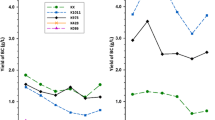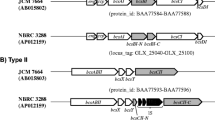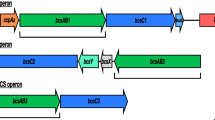Abstract
The conversion of a cellulose-producing cell (Cel +) fromGluconacetobacter hansenii PJK (KCTC 10505 BP) to a non-cellulose-producing cell (Cel −) was investigated by measuring the colony forming unit (CFU). This was achieved in a shaking flask with three slanted baffles, which exerted a strong shear stress. The addition of organic acid, such as glutamic acid and acetic acid, induced the conversion of microbial cells from a wild type toCel − mutants in a flask culture. The supplementation of 1% ethanol to the medium containing an organic acid depressed the conversion of the microbial cells toCel − mutants in a conventional flask without slanted baffles. The addition of ethanol to the medium containing an organic acid; however, accelerated the conversion of microbial cells in the flask with slanted baffles. TheCel + cells from the agitated culture were not easily converted intoCel −, mutants on the additions of organic acid and ethanol to a flask without slanted baffles, but some portion of theCel + cells were converted toCel − mutants in a flask with slanted baffles. The conversion ratio ofCel + cells toCel − mutants was strongly related to the production of bacterial cellulose independently from the cell growth.
Similar content being viewed by others
References
Park, J. K., Y. H. Park, and J. Y. Jung (2003) Production of bacterial cellulose byGluconacetobacter hansenii isolated from rotten apple.Biotechnol. Bioprocess Eng. 8: 83–88.
Matthysse, A. G., D. L. Thomas, and A. R. White (1995) Mechanism of cellulose synthesis inAgrobacterium tumefaciens.J. Bacteriol. 177: 1076–1081.
Brown, A. J. (1886) An acetic acid ferment which forms cellulose.J. Chem. Soc. 49: 432–439.
Delmer, D. P. and Y. Amor (1995) Cellulose biosynthesis.Plant Cell 7: 987–1000.
Yamanaka, S., K. Watanabe, N. Kitamura, M. Iguchi, S. Mitsuhashi, Y. Nishi, and M. Uryu (1989) The structure and mechanical properties of sheets prepared from bacterial cellulose.J. Mat. Sci. 24: 3141–3145.
Cannon, R. E. and S. M. Anderson (1991) Biogenesis of bacterial cellulose.Crit. Rev. Microbiol. 17: 435–447.
Yoshino, T., T. Asakura, and K. Toda (1996) Cellulose production byAcetobacter pasteurianus on silicone membrane.J. Ferment. Bioeng. 81: 32–36.
Klemm, D., D. Schumann, U. Udhard, and S. Marsch (2001) Bacterial synthesized cellulose: Artificial blood vessels for microsurgery.Prog. Polym. Sci. 26: 1561–1603.
Vandamme, E. J., S. De Baets, A. Vanbaelen, K. Joris, and P. De Wulf (1998) Improved production of bacterial cellulose and its application potential.Polym. Degrad. Stabil. 59: 93–99.
Jeong, Y. J. and I. S. Lee (2000) A view of utilizing cellulose produced byAcetobacter bacteria.Food Ind. Nutr. 5: 25–29.
Orodera, M., I. Harashima, K. Toda, and T. Asakura (2002) Silicone rubber membrane bioreactors for bacterial cellulose production.Biotechnol. Bioprocess Eng. 7: 289–294.
Valla, S. and J. Kjosbakken (1981) Cellulose-negative mutants ofAcetobacter xylinum.J. General Microb. 128: 1401–1408.
Park, J. K., J. Y. Jung, and Y. H. Park (2003) Cellulose production byGluconacetobacter hansenii in a medium containing ethanol.Biotechnol. Lett. 25: 2055–2059.
Schramm, M. and S. Hestrin (1954) Factors affecting production of cellulose at the air/liquid interface of a culture ofAcetobacter xylinum.J. General Microb. 11: 123–129.
Coucheron, D. H. (1991) AnAcetobacter xylinum insertion sequence element associated with inactivation of cellulose production.J. Bacteriol. 173: 5723–5731.
Son, H. J., O. M. Lee, Y. G. Kim, Y. K. Park, and S. J. Lee (2000) Characteristics of cellulose production byAcetobacter sp. A9 in static culture.Kor. J. Biotechnol. Bioeng. 15: 573–577.
Toyosaki, H., T. Naritomi, A. Seto, M. Matsuoka, T. Tsuchida, and F. Yoshinaga (1995) Screening of bacterial cellulose-producingAcetobacter strains suitable for agitated culture.Biosci. Biotechnol. Biochem. 59: 1498–1502.
Pyun, Y. R. (2002) Method of manufacturing microbial cellulose employing soybean processed product.Korea Patent KP2002-0080802.
Lee, H. C. (1999) Medium for producing microbial cellulose and preparation method of microbial cellulose using the same.Korea Patent KB10-0197357.
Author information
Authors and Affiliations
Corresponding author
Rights and permissions
About this article
Cite this article
Park, J.K., Hyun, S.H. & Jung, J.Y. Conversion ofG. hansenii PJK into non-cellulose-producing mutants according to the culture condition. Biotechnol Bioproc E 9, 383–388 (2004). https://doi.org/10.1007/BF02933062
Received:
Accepted:
Issue Date:
DOI: https://doi.org/10.1007/BF02933062




